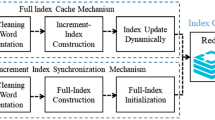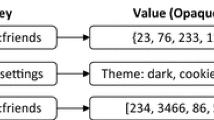Abstract
Most work on multimedia storage systems has assumed that clients will be serviced using a round-robin strategy. The server services the clients in rounds and each client is allocated a time slice within that round. Furthermore, most such algorithms are evaluated on the basis of a tightly specified cost function. This is the basis for well known algorithms such as FCFS, SCAN, SCAN-EDF, etc.
In this paper, we describe a Request Merging (RM) module that takes as input, a set of client requests, and a set of constraints on the desired performance such as client waiting time or maximum disk bandwidth, and a cost function. It produces as output, a Unified Read Request (URR), telling the storage server which data items to read, and when the clients would like these data items to be delivered to them. Given a cost function cf, a URR is optimal if there is no other URR satisfying the constraints with a lower cost. We present three algorithms in this paper, each of which accomplishes this kind of request merging. The first algorithm OptURR is guaranteed to produce minimal cost URRs with respect to arbitrary cost functions. In general, the problem of computing an optimal URR is NP-complete, even when only two data objects are considered. To alleviate this problem, we develop two other algorithms, called GreedyURR and FastURR that may produce sub-optimal URRs, but which have some nicer computational properties. We will report on the pros and cons of these algorithms through an experimental evaluation.
Similar content being viewed by others
References
N.H. Balkir and G. Ozsoyoglu, “Delivering presentations from multimedia servers,” VLDB Journal, to appear.
S. Berson, S. Ghandeharizadeh, R. Muntz, and X. Ju, “Staggered striping in multimedia information systems,” in Proc. of ACM SIGMOD Conference, 1994, pp. 79–90.
M. Budhikot, G. Parulkar, and J.R. Cox Jr, “Design of a large scale video server,” Journal of Computer Networks and ISDN Systems, pp. 504–517, 1994.
H.J. Chen, A. Krishnamurthy, T.D.C. Little, and D. Venkatesh, “A scalable video-on-demand service for the provision of VCR-like functions,” in Proc. of Int. Conf. on Multimedia Computing and Systems, 1995, pp. 65–72.
M.S. Chen, D.D. Kandlur, and P.S. Yu, “Support for fully interactive playout in a disk-array-based video server,” in Proc. of ACM Multimedia, 1994, pp. 391–398.
A. Dan and D. Sitaram, “Ageneralized interval caching policy for mixed interactive and long videoworkloads,” in Proc. of Multimedia Computing and Networking, San Jose, 1996.
A.L. Drapeau, D.A. Patterson, and R.H. Katz, “Toward workload characterization of video server and digital library application,” in Proc. of ACMSigmetrics Conf. on Measurement and Modeling of Computer Systems, Nashville, 1994.
M. Garey and D. Johnson, Computer and Intractability: A Guide to the Theory of NP-Completeness, Freeman and Company: New York, 1979.
L. Golubchik, J. Lui, and R. Muntz, “Reducing I/O demand in video-on-demand storage servers,” in Proc. of ACM Sigmetrics Conf. on Measurement and Modeling of Computer Systems, 1995, pp. 25–36.
Y.M. Huang and S.L. Tsao, “An efficient disk layout scheme for multi-disks continuous media servers,” Multimedia Tools and Applications Journal, Kluwer Academic Publishers, Vol. 9, No. 2, pp. 147–166, 1999.
G. Nerjes, P. Muth, M. Paterakis, Y. Rompogiannakis, P. Triantafillou, and G. Weikum, “Scheduling strategies for mixed workloads in multimedia information servers,” in Proc. of Int. Workshop on Research Issues in Data Engineering, Orlando, Florida, 1998.
R.T. Ng and J. Yang, “Maximizing buffer and disk utilizations for news on-demand,” in Proc. of VLDB Conference, Chile, 1994.
R.T. Ng and Paul Shum, “Optimal clip ordering for news on-demand queries,” in Proc. of Int. Workshop on Multimedia Information Systems, New York, 1996.
S. Chaudhuri, S. Ghandeharizadeh, and C. Shahabi, “Avoiding retrieval contention for composite multimedia objects,” in Proc. of VLDB Conference, Zurich, Swizerland, 1995.
E. Hwang and B. Prabhakaran, “Merging retrieval requests for multimedia storage server,” in Proc. of Int. Workshop on Intelligent Multimedia Computing and Networking, New Jersey, 2000.
E. Hwang, B. Prabhakaran, and V.S. Subrahmanian, “Presentation planning for distributed VoD systems,” to appear in Trans. on Knowledge and Data Engineering.
Y. Rompogiannakis, G. Nerjes, P. Muth, M. Paterakis, P. Triantafillou, and G. Weikum, “Disk scheduling for mixed-media workloads in a multimedia server,” in Proc. of ACM Multimedia, 1998, pp. 297–302.
P. Venkat Rangan and H. Vin, “Designing file systems for digital video and audio,” in Proc. of ACM Symposium on Operating Systems Principles, 1991, pp. 69–79.
C.L. Liu and J.W. Layland, “Scheduling algorithms for multiprogramming in a hard real-time environment,” Journal of the ACM, Vol. 20, No. 1, pp. 46–61, 1973.
J.Y. Leung and M.L. Merrill, “A note on preemptive scheduling of periodic real-time tasks,” Information Processing Letters, Vol. 11, No. 3, pp. 115–118, 1980.
Video Store Magazine, 1992.
Author information
Authors and Affiliations
Rights and permissions
About this article
Cite this article
Hwang, E., Prabhakaran, B. Unified Read Requests. Multimedia Tools and Applications 20, 203–224 (2003). https://doi.org/10.1023/A:1024058404247
Issue Date:
DOI: https://doi.org/10.1023/A:1024058404247




